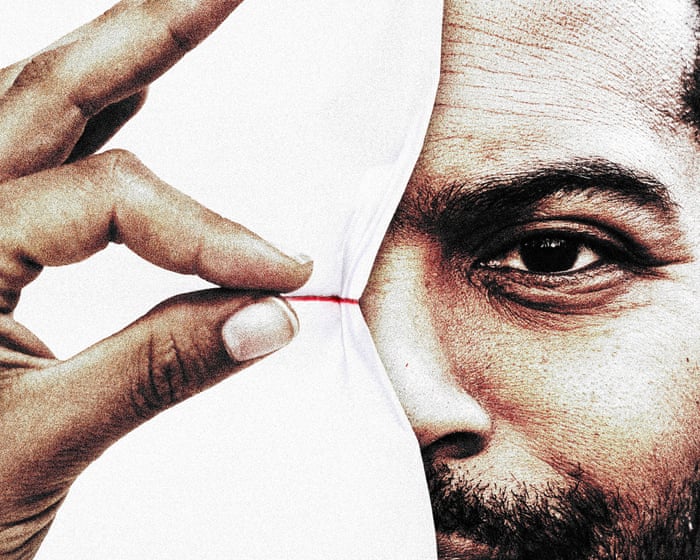This CSS code defines a custom font family called “Guardian Headline Full” with multiple font weights and styles. It includes light, regular, medium, and semibold weights, each in both normal and italic styles. The font files are provided in WOFF2, WOFF, and TrueType formats, hosted on the Guardian’s asset server.@font-face {
font-family: ‘Guardian Headline Full’;
src: url(‘https://assets.guim.co.uk/static/frontend/fonts/guardian-headline/noalts-not-hinted/GHGuardianHeadline-Bold.woff2’) format(‘woff2’),
url(‘https://assets.guim.co.uk/static/frontend/fonts/guardian-headline/noalts-not-hinted/GHGuardianHeadline-Bold.woff’) format(‘woff’),
url(‘https://assets.guim.co.uk/static/frontend/fonts/guardian-headline/noalts-not-hinted/GHGuardianHeadline-Bold.ttf’) format(‘truetype’);
font-weight: 700;
font-style: normal;
}
@font-face {
font-family: ‘Guardian Headline Full’;
src: url(‘https://assets.guim.co.uk/static/frontend/fonts/guardian-headline/noalts-not-hinted/GHGuardianHeadline-BoldItalic.woff2’) format(‘woff2’),
url(‘https://assets.guim.co.uk/static/frontend/fonts/guardian-headline/noalts-not-hinted/GHGuardianHeadline-BoldItalic.woff’) format(‘woff’),
url(‘https://assets.guim.co.uk/static/frontend/fonts/guardian-headline/noalts-not-hinted/GHGuardianHeadline-BoldItalic.ttf’) format(‘truetype’);
font-weight: 700;
font-style: italic;
}
@font-face {
font-family: ‘Guardian Headline Full’;
src: url(‘https://assets.guim.co.uk/static/frontend/fonts/guardian-headline/noalts-not-hinted/GHGuardianHeadline-Black.woff2’) format(‘woff2’),
url(‘https://assets.guim.co.uk/static/frontend/fonts/guardian-headline/noalts-not-hinted/GHGuardianHeadline-Black.woff’) format(‘woff’),
url(‘https://assets.guim.co.uk/static/frontend/fonts/guardian-headline/noalts-not-hinted/GHGuardianHeadline-Black.ttf’) format(‘truetype’);
font-weight: 900;
font-style: normal;
}
@font-face {
font-family: ‘Guardian Headline Full’;
src: url(‘https://assets.guim.co.uk/static/frontend/fonts/guardian-headline/noalts-not-hinted/GHGuardianHeadline-BlackItalic.woff2’) format(‘woff2’),
url(‘https://assets.guim.co.uk/static/frontend/fonts/guardian-headline/noalts-not-hinted/GHGuardianHeadline-BlackItalic.woff’) format(‘woff’),
url(‘https://assets.guim.co.uk/static/frontend/fonts/guardian-headline/noalts-not-hinted/GHGuardianHeadline-BlackItalic.ttf’) format(‘truetype’);
font-weight: 900;
font-style: italic;
}
@font-face {
font-family: ‘Guardian Titlepiece’;
src: url(‘https://assets.guim.co.uk/static/frontend/fonts/guardian-titlepiece/noalts-not-hinted/GTGuardianTitlepiece-Bold.woff2’) format(‘woff2’),
url(‘https://assets.guim.co.uk/static/frontend/fonts/guardian-titlepiece/noalts-not-hinted/GTGuardianTitlepiece-Bold.woff’) format(‘woff’),
url(‘https://assets.guim.co.uk/static/frontend/fonts/guardian-titlepiece/noalts-not-hinted/GTGuardianTitlepiece-Bold.ttf’) format(‘truetype’);
font-weight: 700;
font-style: normal;
}
@media (min-width: 71.25em) {
.content__main-column–interactive {
margin-left: 160px;
}
}
@media (min-width: 81.25em) {
.content__main-column–interactive {
margin-left: 240px;
}
}
.content__main-column–interactive .element-atom {
max-width: 620px;
}
@media (max-width: 46.24em) {
.content__main-column–interactive .element-atom {
max-width: 100%;
}
}
.content__main-column–interactive .element-showcase {
margin-left: 0;
}
@media (min-width: 46.25em) {
.content__main-column–interactive .element-showcase {
max-width: 620px;
}
}
@media (min-width: 71.25em) {
.content__main-column–interactive .element-showcase {
max-width: 860px;
}
}
.content__main-column–interactive .element-immersive {
max-width: 1100px;
}
@media (max-width: 46.24em) {
.content__main-column–interactive .element-immersive {
width: calc(100vw – var(–scrollbar-width));
position: relative;
left: 50%;
right: 50%;
margin-left: calc(-50vw + var(–half-scrollbar-width)) !important;
margin-right: calc(-50vw + var(–half-scrollbar-width)) !important;
}
}
@media (min-width: 46.25em) {
.content__main-column–interactive .element-immersive {
transform: translate(-20px);
width: calc(100% + 60px);
}
}
@media (max-width: 71.24em) {
.content__main-column–interactive .element-immersive {
margin-left: 0;
margin-right: 0;
}
}
@media (min-width: 71.25em) {
.content__main-column–interactive .element-immersive {
transform: translate(0);
width: auto;
}
}
@media (min-width: 81.25em) {
.content__main-column–interactive .element-immersive {
max-width: 1260px;
}
}
.content__main-column–interactive p,
.content__main-column–interactive ul {
max-width: 620px;
}
.content__main-column–interactive:before {
position: absolute;
top: 0;
height: calc(100% + 15px);
min-height: 100px;
content: “”;
}
@media (min-width: 71.25em) {
.content__main-column–interactive:before {
left: -10px;
}
}This appears to be a block of CSS code, likely from a website’s stylesheet. It defines various styles for elements such as columns, interactive content, and typography, including colors, spacing, and layout rules for different screen sizes. The code includes media queries for responsive design and uses CSS custom properties (variables) for consistent theming.The following CSS rules adjust the layout and styling for various elements:
– Paragraphs following horizontal rules in specific containers have no top padding.
– Captions for showcase elements are positioned statically, with a full width and a maximum width of 620px.
– Immersive elements span the full viewport width, minus the scrollbar width.
– For screens up to 71.24em wide, immersive elements are limited to 978px, and their captions have 10px horizontal padding.
– Between 30em and 71.24em, captions for immersive elements have 20px horizontal padding.
– For screens between 46.25em and 61.24em, immersive elements are limited to 738px.
– Below 46.24em, immersive elements are aligned to the left with adjusted margins.
– Between 30em and 46.24em, immersive elements have a left margin of -20px and captions with 20px horizontal padding.
– For screens 61.25em and wider, a grid layout is applied with specific column and row definitions.
– Headlines in this grid have a top border.
– Meta information is positioned relatively with top padding and no right margin.
– Standfirst elements have adjusted margins, font sizes, and link styles, including underlined links with specific colors and hover effects.
– The first paragraph in standfirst elements has a top border and no bottom padding, which is removed at 71.25em and above.
– Figures in the grid have left margins and a maximum width of 630px for inline elements.
– At 71.25em and above, the grid template is adjusted with different column and row definitions.The provided text appears to be CSS code for styling a webpage layout, specifically for a furniture-wrapper class. It defines grid structures, media queries for responsive design, and various styling rules for elements like headlines, meta information, standfirst text, and media captions. The code adjusts properties such as widths, fonts, borders, and colors based on screen size breakpoints.The second element of its type should be displayed as a block with a maximum width of 90%.
On screens at least 30em wide, captions within the furniture wrapper should have padding of 4px at the top, 20px on the sides, and 12px at the bottom. Captions with the “hidden” class should be invisible.
A caption button inside the furniture wrapper is displayed as a block, positioned absolutely 10px from the bottom and 8px from the right, with a high stacking order. It has a background color defined by the variable –captionBackground, no border, a circular shape, and padding of 6px at the top, 5px on the sides, and 5px at the bottom. The SVG inside is scaled to 85% of its original size. On screens at least 30em wide, the button is positioned 10px from the right.
For the main interactive column on screens at least 71.25em wide, the top position is adjusted by -12px and the height is increased by 24px. Headings (h2) in this column have a maximum width of 620px.
On iOS and Android devices, the color variables are set as follows: –darkBackground to #1a1a1a, –feature to #c70000, –darkmodeFeature to #ff5943, and –new-pillar-colour to the value of –primary-pillar or –feature if not defined. In dark mode, –new-pillar-colour uses –darkmode-pillar or –darkmodeFeature.
For the first letter of the first paragraph following specific elements in article containers on iOS and Android, the color is set to the value of –secondary-pillar or black if not defined.
Headers in article containers on iOS and Android have no height. The furniture wrapper in these containers has padding of 4px at the top, 10px on the sides, and 0 at the bottom. Labels within the furniture wrapper use a bold, 700-weight font from the Guardian Headline or Guardian Egyptian Web font families.The headline font is set to Guardian Headline, Georgia, or serif, with a specific color and capitalized text. On iOS and Android devices, the headline in article containers uses a 32px bold font, has 12px bottom padding, and is colored dark gray.
Images in these containers are positioned relatively, with a 14px top margin and a left margin of -10px. Their width adjusts to the viewport minus the scrollbar, and their height is set to auto. The inner elements, images, and links within these figures have a transparent background, the same responsive width, and auto height.
The standfirst section has 4px top padding, 24px bottom padding, and a -10px right margin. Paragraphs inside the standfirst use the Guardian Headline or Georgia font family. Links within the standfirst and its list items are styled accordingly.For iOS and Android devices, links within the standfirst section of feature, standard, and comment articles are styled with a specific color, an underline 6px below the text, and no background image or bottom border. When hovered, the underline color changes to match the text color.
The meta section in these containers has no margin, and elements like bylines, authors, and related links are styled consistently.For iOS and Android devices, the following styling applies to article containers:
– Author byline links use the new pillar color.
– Meta section misc elements have no padding.
– SVG icons in the meta misc section use the new pillar color for strokes.
– Caption buttons in showcase elements are centered, 28x28px, with 5px padding, positioned 14px from the right.
– Article body has 12px horizontal padding.
– Non-thumbnail, non-immersive images span the viewport width minus 24px and scrollbar width, with no margin and auto height. Their captions have no padding.
– Immersive image elements are styled similarly.For immersive images in standard and comment articles on Android, set the width to the full viewport width minus the scrollbar width.
On iOS and Android, for feature, standard, and comment articles, style quoted blockquotes with a color based on the new pillar color. Also, style links in the prose with the primary pillar color, an underline offset by 6px, and an underline color matching the header border. On hover, change the underline color to the new pillar color.
In dark mode, set the background color of furniture wrappers to #1a1a1a. Style content labels with the new pillar color, headlines with the header border color, and standfirst paragraphs with the header border color. Also, style standfirst links and byline authors with the same header border color.This CSS code sets the color of author bylines to a specific variable-defined color on both iOS and Android devices for various article types. It also applies the same color to SVG strokes in the meta section and to quoted text within articles. Additionally, it defines the color for image captions using another variable. The code targets multiple containers and elements to ensure consistent styling across different layouts and platforms.On iOS devices, the first letter of paragraphs following specific elements in article and comment sections is styled with a custom drop cap. This applies to various containers and content types, including standard articles, feature articles, and interactive content.This CSS selector targets the first letter of paragraphs that follow specific elements within various article containers on iOS and Android devices. It applies to different sections like article bodies, comment areas, and interactive content, ensuring consistent styling for drop caps or initial letter formatting.For Android devices, the first letter of the first paragraph in comment article containers is styled with a specific color. On both iOS and Android, comment article containers have adjusted padding and margins for certain elements. Headings at level two use a 24-pixel font size. Caption buttons have different padding values on iOS and Android.
In dark mode, text and icon colors change to improve readability. Logos in the branding section are set to display. Labels and headlines in article containers use a medium font weight. The page background and related sections use a custom color variable, which switches to a dark shade in dark mode.
Some elements are hidden, and the layout of the furniture wrapper adjusts based on screen size, particularly when a thumbnail is present. These changes ensure the design remains consistent and responsive across different devices and themes.For screens wider than 71.25em, the furniture-wrapper with a thumbnail uses a grid layout with specific row sizes for the title, portrait, headline, standfirst, and meta sections.
Headlines and links within the furniture-wrapper have a light font weight (200), no maximum width, and a font size of 32px. On larger screens (min-width: 71.25em), the font size increases to 50px. When hovered, these elements show a 2px thick underline with a 6px offset.
Byline text (excluding elements with gu-island) uses a 32px font size and very light weight (100), increasing to 50px on larger screens. Inner divs within the headline have no bottom padding.
The standfirst section is positioned relatively. Its paragraphs, links, and list items use a very light font weight (100). On medium screens (min-width: 61.25em), it has no top padding, and on larger screens (min-width: 71.25em), it has a 2px top padding.
The portrait-mainmedia headline wrapper is full height, relatively positioned, and hides overflow. It includes a bottom gradient effect using a repeating linear pattern. On smaller screens (max-width: 61.24em), this effect has a 4px bottom margin.
Thumbnail figures within this wrapper span the full width with no side margins and an 18px bottom margin. The image container adjusts its height automatically. The image and its link are displayed as flex items, with the image set to 120px wide and aligned to the right. On larger screens, the image width increases to 140px. Captions are hidden.
If no thumbnail is present, the wrapper adds 28px of bottom padding.
In the main content column, the first letter of the first paragraph uses a font weight of 300, and level-2 headings are colored #8d2700 or use a CSS variable for drop-cap color.The main heading uses a 28px font with a normal style and light weight, and has a bottom margin of 8px. On larger screens, the heading increases to 32px.
For iOS and Android devices, the background color is set to white. On these devices, labels are hidden, and headings use a medium weight by default but switch to a light weight and 28px size in specific containers.
In light mode, the background color for opinion sections is a light peach (#fef9f5), while in dark mode, it changes to a dark gray (#1a1a1a) with an orange accent (#ff7f0f). Some elements, like thumbnails, have added bottom padding of 22px.For iOS and Android devices, the following styles apply to feature, standard, and comment article containers:
– Thumbnail images are set to 120px wide with a 10px right margin.
– Thumbnail captions are hidden.
– Image elements have a left margin of -10px.
– Standfirst elements have no top margin, 8px top padding, and no before pseudo-element.
– Text inside standfirst (paragraphs, links, list items) uses a thin font weight, 17px font size, and 115% line height.
– Meta elements before the furniture wrapper are hidden.For iOS and Android devices, the following CSS rules apply:
– The `:before` pseudo-elements for `.meta` and `.keyline` within `.furniture-wrapper` in feature, standard, and comment article containers are positioned 4 pixels above their normal location.
– Rich link elements (`aside.element-rich-link`) in the same containers are hidden.
– The `#cutout-container` within `#comment-header` in these containers is also hidden with high priority.
– The first letter of the first paragraph following the first `.element-atom` in `#article-body` has a font weight of 300.
– In comment bodies and elements with `data-gu-name=body`, the first letter of the first paragraph after an `.element-atom`, `.sign-in-gate`, or `#sign-in-gate` has a font weight of 300 and no top padding.
– H2 headings are styled with a specific color (#8d2700), font size (28px), normal style and weight (300), normal line height, and margins (28px top, 0 right, 8px bottom, 0 left).
– On Android, the `#cutout-container` is hidden.
In dark mode:
– A gradient background is applied to `.portrait-mainmedia__headline-wrapper:after`.
– The first letter of non-first paragraphs in comment bodies and `[data-gu-name=body]` is set to white.
– H2 headings in these sections use a custom color variable (–byline, defaulting to #c74600).
—
Katharine Viner
Sometimes, you just need to pull on the thread.
That’s how it began for two Guardian reporters in the spring of 2021, when they started looking into allegations about the behavior of Noel Clarke, a well-known British actor and filmmaker.
Sirin Kale and Lucy Osborne spoke to numerous sources, including moMore than 20 women shared their experiences of working with Clarke, accusing him of various forms of misconduct, including sexual harassment, unwanted touching and groping, sexually inappropriate behavior, taking and sharing explicit photos and videos without consent, and bullying. These allegations, spanning from 2004 to 2019, formed the basis of a powerful series of articles and a podcast by the Guardian, which led Clarke to sue the publication.
The six-week trial took place at the High Court in March and April, with the judgment delivered today. Mrs Justice Steyn ruled that the Guardian’s reporting was true and in the public interest. She commended the reporters and editors for their thorough approach, noting the extensive efforts they made to investigate, verify, and corroborate the information they received, while refraining from publishing unsubstantiated claims.
This is a resounding victory for the women who came forward, for the Guardian, and for investigative journalism in Britain.
Throughout my decade as editor-in-chief of the Guardian, I’ve faced many difficult decisions, but choosing to fight Noel Clarke’s defamation claim was not one of them. From the start, I believed this was a case we had to see through to the end—primarily for the women who shared their stories in our original investigation and those who later testified in court.
When I first learned about the investigation, what struck me was its sheer scale. Even in the wake of the #MeToo movement, it’s rare for women to speak out against powerful figures, especially in the film and TV industry, where doing so carries significant risk. Yet, with each update from our investigations team, the number of women coming forward grew. Within days, we had more than a dozen sources. By the time we published our first article, we had credible firsthand accounts from 22 women, backed by extensive corroboration from our reporters. By our final article, we had spoken to more than 100 sources.
At trial, we relied on testimony from 26 individuals, some of whom traveled from abroad to appear in court. These women did not waver, despite facing intimidating tactics before and during the proceedings. I attended court most days and was deeply moved by their powerful, committed accounts of some of the most painful moments of their lives. As Michaela Coel wrote about our sources, speaking about these incidents requires immense strength, especially when some dismiss them as “grey areas.” In reality, these behaviors are unprofessional, violent, and can irreparably damage a person’s self-perception, place in the world, and career.
One key witness, Gina Powell, a former employee of Clarke’s, accused him of sexual assault and testified that she spoke out because she didn’t believe he should be around young women in the film industry. Her courage, like that of all our witnesses, was extraordinary. Mrs Justice Steyn described her as an impressive, honest, and compelling witness who did not exaggerate, adding that courage is shown not by the absence of fear, but by mastering it—a quality Ms Powell demonstrated admirably.
The Guardian stood by Gina and all these women, and the media as a whole will benefit from their bravery, thanks to a judgment that has fully vindicated them.Their decision to speak out makes this judgment a victory for them.
It also serves as a significant vindication for the Guardian—our reporters, editors, and lawyers. Investigative journalism is both risky and costly, and reporting on allegations of sexual misconduct is notoriously difficult to publish. There is always the looming threat of litigation, which is draining and time-consuming. It also takes a toll on witnesses, many of whom have already endured abuse and may understandably feel unable to face the trauma of a grueling court case.
Our journalists face similar challenges. Six of us were cross-examined in the high court. One reporter spent three days on the stand, while another faced intensely personal questioning. Unfounded accusations of a “conspiracy” were made. Throughout it all, everyone performed admirably, defending journalism in the public interest and standing up for the Guardian.
Then there is the risk of crippling legal costs. At one point, in what seemed an attempt to pressure us into settling on his terms before trial, Noel Clarke tried to increase his damages claim to a staggering £70 million.
The Guardian is fortunate to have the support of the Scott Trust, our owners, who prioritize public interest journalism over commercial or political goals. They stood by this reporting at every stage.
Few defamation cases go to trial because of the financial and reputational risks involved. But this was a case where the Guardian needed to take a stand—to trust the women, our journalism, and the legal process.
This is a good day for the Guardian, for public interest media, and for women.
Katharine Viner is editor-in-chief of the Guardian
Do you have an opinion on the issues raised in this article? If you would like to submit a response of up to 300 words by email for consideration in our letters section, please click here.
Frequently Asked Questions
FAQs about the Noel Clarke Ruling and Katharine Viners Article
1 Who is Noel Clarke
Noel Clarke is a British actor director and screenwriter known for roles in shows like Doctor Who and films like Kidulthood He faced multiple allegations of misconduct
2 What was the Noel Clarke ruling about
The ruling referred to the outcome of an investigation into allegations of sexual harassment bullying and other inappropriate behaviors made against Clarke by multiple women
3 Who is Katharine Viner
Katharine Viner is the editorinchief of The Guardian the newspaper that published the initial investigation into the allegations against Noel Clarke
4 What did Katharine Viner say in her article
Viner described the ruling as a victory for the women who came forward with their stories and for journalism emphasizing the importance of holding powerful figures accountable
5 Why is this considered a victory for the women involved
It validated their experiences showed that speaking out can lead to accountability and may encourage others to share their stories without fear
6 How is this a victory for journalism
It demonstrates the role of investigative journalism in uncovering truth giving a voice to the marginalized and challenging abuse of power
7 What were the specific allegations against Noel Clarke
Allegations included sexual harassment unwanted touching bullying and sharing explicit images without consent as reported by The Guardian
8 Did Noel Clarke face any legal consequences
While some professional repercussions occurred specific legal outcomes may vary and werent fully detailed in the ruling discussed
9 How did the public and industry react to the allegations
Many expressed support for the accusers and Clarke faced professional setbacks including dropped projects and revoked awards
10 What impact could this have on future cases
It may inspire more people to report misconduct and push media outlets to pursue similar investigations fostering a culture of accountability
11 Were there any criticisms of the ruling or the article
Some may argue about fairness to the accused or question media bias though the focus was largely on supporting survivors
12 How can someone support survivors of misconduct
Listen without judgment believe their stories advocate for safe reporting channels and promote respectful behavior in workplaces and communities




